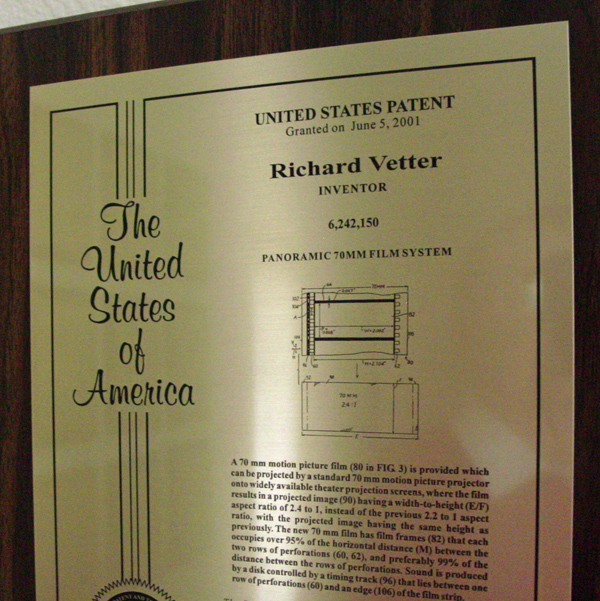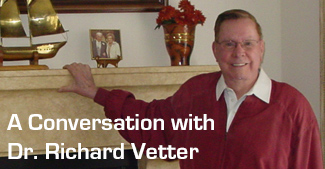A Conversation with Dr. Richard Vetter | Read more at in70mm.com The 70mm Newsletter |
| Written by: Paul Rayton, interviewed 22. February 2006. This text is edited, clarified for reading in February 2024 | Date: 22.02.2024 |
 Paul Rayton and Richard Vetter in his home in Carlsbad, California, 22. February 2006. Image by Paul Rayton Paul Rayton and Richard Vetter in his home in Carlsbad, California, 22. February 2006. Image by Paul RaytonIn Feb. of 2006, Paul Rayton visited Dr. Richard Vetter at the Vetter home in Carlsbad, California, about mid-way between Los Angeles and San Diego. In a free-ranging and very casual interview, Mr. Rayton reminisced with Dr. Vetter about his life history and experiences. Dr. Vetter had many patents issued to him over his career, but he seemed proudest of the one for the 70mm process which was called "Dimension 150", or D-150. • Go to Come Back D-150 .... All Is Forgiven • Go to Motion pictures in Dimension 150 • Go to The D-150 Curvulon Lens • Go to Richard Vetter Passed Away | More in 70mm reading: in70mm.com's page about Dimension 150 in70mm.com's Library Motion pictures photographed in Dimension 150 Richard Vetter Passed Away Presented on the big screen in 7OMM Peripheral Vision, Scopes, Dimensions and Panoramas |
 Richard Vetter in his home 26.03.2006. Picture: Paul Rayton Richard Vetter in his home 26.03.2006. Picture: Paul RaytonRichard: When I was in high school, I was the official projectionist. That was here at Hoover High School, in San Diego. I was about 17 years old when I graduated, and I was tired of school, so I wanted to join the Navy. I had a hard time getting my parents to sign for it because I was kind of young. But anyhow, to make a Long story short, I got into the Navy and of course I went through 12 weeks of boot camp here in San Diego. Then I got sent down to Florida, and got into aerial photography at the Pensacola Naval Air Station, which was a six month course, you know. Paul: From the ground up? Richard: Yeah, still photography, and then aerial, and so forth. So I was down there and I was, I guess rated as maybe a Seaman 2nd Class by the time I got to Pensacola. So I went to the movies on the base one night. There was a sign, and they were advertising for a projectionist, and I got the idea of going to see the Entertainment Officer and applying for the job. Of course, I had never touched 35mm film, only 16mm before that time, but I went to see him and he said “Oh well. Good!”. And I told him, I said, you know, sure I've run Simplex and Motiograph, and I was exaggerating and lying a bit. So I said, "I gotta brush up. So if somebody's got some manuals on running these projectors, I'd like to study those manuals a little bit". And then after reading them, I went out on training with an experienced projectionist. And I managed to get the job. Anyhow, the great thing was, we used to have to do four-hour watch intervals, you know, every day, and they took me off that. They paid me extra for my projection work, for being a projectionist, and I never had to stand watch duty again at Pensacola. Paul: Watch? You mean standing guard? Richard: Yeah, 4 hours per watch, four hours, and I seemed to usually pull like the midnight to 4:00 AM time slot, or something inconvenient like that. But anyhow, that's where I learned to handle, really handle professional film, and I had that as part of my education. So it was aerial photography and photography, plus being a projectionist and so forth that, you know, got me on the right track. We did everything there, we'd fly around in these, these SNJs [trainer aircraft type - ed] and we'd fly around and we'd bank and we'd take pictures of this and pictures of that. And then of course we did mapping where we got Beechcraft planes, and we'd get the 18 by 18 camera mounted in the bottom of the plane. And we would navigate around and we would do a lot of mapping, and so forth. Yeah, we did everything, Vectorgraphs, maps, 3D. And all kinds of things, it was fun. Anyhow, that's how I got, you know, one thing led to another, and that's how I got into the movie business and got started. | |
 Richard Vetter with some of his patents on display in his office. Picture: Paul Rayton Richard Vetter with some of his patents on display in his office. Picture: Paul RaytonPaul: And I think you said one time that, after the Navy, you came up to UCLA and took classes up there? What were you specializing in? Was it optical work in particular? Richard: Oh, yeah, right. I was doing three things. I was taking classes in the Theater Arts Division at that time. I was also teaching as an instructor at UCLA extension [off-campus classes - ed]. And I was taking a lot of of physics courses, because I was so interested in it, particularly in optics and so forth. I was there from 1954 to 1963. That was when they called me the perennial student [laughs]. But I got my PhD there. I made one visit to Bausch and Lomb, back around 1963 or 64. I actually made a trip around the world, trying to find somebody to make the D-150 Curvulon projection lenses. And I ended up with Kollmorgen, giving the contract to Kollmorgen. But I went to Cooke in the UK, and I went to Japan and France, looking for someone who would make those lenses because they were, as you know, big and expensive. B&L they had been pretty popular, as you know, with CinemaScope projection, but by the time I came along in the early 60s, most of the people at B&L were not very interested. But Kollmorgen was, and that's where I met Glenn Berggren. Paul: He was with Kollmorgen for a long time, and I guess he is kind of still there, in the sense that Kollmorgen products were merged into Schneider Co., as the years went by. Richard: Isco grew out of Schneider company, they were brothers or something. We dealt with Isco quite a bit, not quite so much Schneider, but with Isco, and they would make special lenses for us in those days. Paul: How many total D-150 screens ultimately were installed ? Richard: We had around 60 worldwide. And we even, you know, helped build theaters, like the one in Tokyo and the Marble Arch in London. I worked with the architects -- Putnam was his name -- for Rank that built the Marble Arch, and that was built, like a lot of theaters were built, from the ground up for D-150. At the Egyptian in Hollywood, when my boss told me we want to restore that theater, and we want to put the D-150 in, I said, “Well, the very first thing we have to do is to build a new booth downstairs. We'll figure out how to do that, but I can't have the booth up on the roof", which is what it was. You had to walk across the roof, even in the rain, to get to the projection booth. • Go to PDF: Odeon Marble Arch D-150 brochure Paul: It’s always good for those prints, getting rained on! What was the first one completed? Was the Egyptian the first one? | |
 Richard Vetter's patent for 'ClearVision Panoramic 7OMM Film System'. Picture: Paul Rayton Richard Vetter's patent for 'ClearVision Panoramic 7OMM Film System'. Picture: Paul RaytonRichard: 1st D-150? uh no. We built a theater from the ground up. A new UA theater at Lefrak City on Long Island. It wasn't a huge theater, but it was built and designed from the beginning for D-150. And that's where we had our East Coast demonstrations of D-150. I would say that the Lefrak theatre goes back to 1963 - 1964 so, yeah, that was the first. Paul: And was that when you showed the “Fortress of Peace”? Richard: No, we didn't have it then. We took clips, well ... we made a demo film with Todd-AO cameras and our D-150 lenses. And then we also put the clips in for -- we called it the all-purpose theater -- so we put clips in from “My Fair Lady” and from “Sound of Music” and the “Agony and the Ecstasy” and so forth, to show the 70mm format using the D-150 process, but they were not 120° as our Theaters, as our D-150 screen was. The very first D-150 installation was our test site at the Rosemary Theater at Pacific Ocean Park, which hadn't run a film in many, many years. The place was sitting there collecting dust, and so we made a deal to take over the lease at the old Rosemary theater at POP and put D-150 in there. That's where we had the Academy and the ASC visit and all of them would come down there, and we would have dinner and go over and look at the 150. Joe Kelly and I were really good friends, and of course, he was working for United Artists. Paul: Right, right, Kelly of Kelmar. Well, I mean, it was Andy Marglin and Joe Kelly who built Kelmar? Richard: Yeah, sure, sure. There you go. And of course, Joe's retired. He's a little older than I am and so forth, but his life ... I did not envy his life! You're talking about working continually. He would go into these theaters and convert them and, you know, all these UA theaters that we had and to make them ready for the ... Paul: D-150? Richard: Well, make them for everything. Not only for D-150, but he had been with them at the beginning, you know, installing CinemaScope and mag sound penthouses and the stereo sound amps and speakers etc. He had, I think, four children, and he lived out on Long Island in a nice house in Glen Cove, but the poor guy was never home. I mean, he was always in theaters, and his wife finally said, “Well, why don't you just, you know, sleep in these theaters?”. Paul: [laughing] Where have I heard that before? Richard: He finally reached a point where, you know, he got some staff together to help. The staff would go out in advance, and he would come in just for the final day, or days, to give them the final approval. But during the '60s and part of the '70s he just constantly traveled. You know, we put in D-150 theaters. We put in six installations in Mexico, just as an example. We did the big theater in Tokyo and so forth. He was the guy that went out and rolled up his sleeves and did the work, and I'd come along at the end and adjust the lenses the night before the premiere. Paul: He [Joe] did the tough work. You handled the glamour part, right? [laughter]. | |
A conversation with Dr Richard Vetter about his early film days, UCLA, Dimension 150 and Joe Kelly | |
 • Go to A Conversation with Dr. Richard Vetter | |
| Go: back - top - back issues - news index Updated 22-02-24 |
